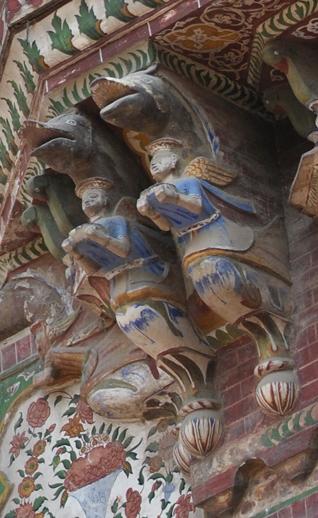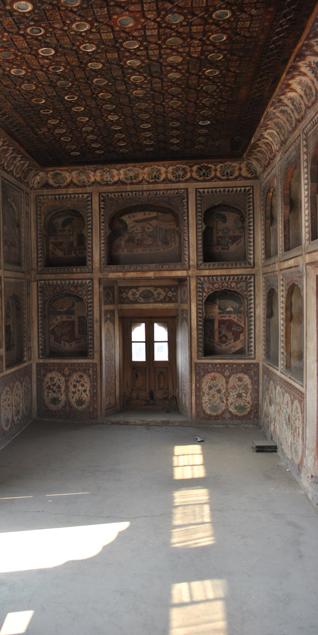Architecture
The Haveli of Maharaja Naunihal Singh:
A Jewel In The Heart of Lahore
Text & Photography by AOWN ALI
haveli - mansion, royal residence [dictionary]
Any one who is looking for significant and superb examples of Sikh architecture in Lahore, Punjab, would definitely not overlook the Haveli of Naunihal Singh, the son of Maharaja Kharak Singh and Rani Chand Kaur, and grandson of Maharaja Ranjit Singh.
In 1840, after the death of Kharak Singh - contrived by a scheme between the British and the Dogra broithers - Naunihal Singh became the Maharaja of Punjab. But, a few days later, he too died in a mysterious incident, obviously a conspiracy hatched by the same vested interests.
After the death of Naunihal Singh, his mother took his place as regent for her grandson, the rightful successor of the throne but after some time, under pressure, she relinquished the throne to Sher Singh, another son of Mahraja Ranjit Singh.
Rani Chand Kaur retired to her son's Haveli after her withdrawal from the throne.
Ultimately the British took over Punjab in 1849 and this Haveli also went under the possession of the British colonial power. In 1860, a girl’s school began here. The school is still ongoing under the name of “Victoria Higher Secondary School”.
One of the few remaining royal residences from the Sikh period, this Haveli is situated inside the old walled city. Located between the historic Bhatti and Lohari gates, where Mori Gate once stood, a zigzag of narrow streets leads to an open area known as “Maidan Bahian” or the 'field of Bahian', once a large garden, the Haveli is situated at the edge of this field.
Currently, there is no remnant of the garden but the Haveli survives with its full glamour and decorative patterns.
It is an intact structure of over forty rooms with most elements of its original ornamentation preserved on the two main elevations and the interior courtyard facades. Rectangular in plan, the Haveli is a fairly large building. Its entrance is on the west side and the façade has been divided into two clear sections: one housing the entrance gate, which is abundantly decorated and the other is simple but has plenty of fenestration. If there was any decoration on this area, it has been destroyed by the ravages of time.
The building has a basement and four storyes above the ground level. O the four, two storeys encompass the whole area; the third storey is partially crumbled while the fourth stands in the northwestern corner and is called “Rang Mahal” - "The Palace of Colours".
The “Rang Mahal”, like the Mughal “Hawa Mahal” or Palace of Winds, was traditionally built on the top of royal residences where fresh breeze could be enjoyed alongwith a view of the surroundings. The “Rang Mahal” of Naunihal Singh’s Haveli serves this purpose well.
It is a jewel of artistic achievement. The wooden roof is richly decorated, divided into several geometrical compartments. Each is fitted with a small mirror in the centre. The northern and western walls have fenestrations in the form of windows and ventilators. There are blind arches in between the windows and ventilators. These arches house miniature paintings depicting mythological scenes (e.g., the fables of Krishna), as well as landscapes and natural scenes.
The paintings are done in Kangra style, a school which flourished in Kashmir, Lahore and Amritsar during the reign of Ranjit Singh. The colors of these paintings are still fresh and speak a lot of the expertise of the Sikh artists. Although this valuable piece of architectural heritage has lost a lot of its interior ornament due to its heavy use as a school building for over a hundred years, this room has been saved due to its location on the top floor. Also, its notoriety as a haunted room has also proved to be a reasonable deterrent.
The rise of Maharaja Ranjit Singh to power and his establishing Lahore as the royal seat, created a new centre of arts and the painters of Kashmir found new patronage at the Lahore Darbar. Thus, a new sub-style of painting known as the Sikh school was developed.
It was not an original style of art but created by amalgam.
Beside the miniature paintings, there are several other kinds of decorative works such as cut brick work, woodwork including carvings and engravings, painted floral motifs and stucco work. The cut brick work, however, is of the finest kind. It seems that Sikh craftsmen especially excelled in this kind of masonry. The carving of the bricks is so sharp, precise and accurate that bricks seem to be made of wax rather than of baked clay.
The wood carving on doors and windows and miniature columns introduced at the corners of the oriel windows are also remarkable.
The building has the status of preserved architecture under the local rules and laws. It serves as a well known educational institution, especially for the female students living in the walled city of Lahore. It provides room for more than 1500 girls between
grades 6 to 10.
While observing the present condition of this historic architecture and comparing it with many others of same era, one reaches the conclusion that the usage of this building as a school is far better than leaving it idle to ultimately crumble into ruins.
The author, a photojournalist based in Lahore, Punjab, Pakistan, is particularly interested in documentary photography. He has photographed dozens of significant historic architecture and archeological sites in Pakistan and Afghanistan. His photographic work is mainly displayed at www.orientalarchitecture.com. His work, including photo stories and research, is widely published in Pakistani newspapers, magazines and websites. He is currently working on the Sikh architectural heritage located in Lahore and other cities of Pakistan.
November 1, 2011
Conversation about this article
1: Baldev Singh (Bradford, United Kingdom), November 01, 2011, 9:00 PM.
We need to preserve these jewels.
2: Jarnail Singh (Liverpool, United Kingdom), November 02, 2011, 7:27 AM.
Groups like Nishkam Seva - who do wonderful seva worldwide - should be created to help the Pakistanis conserve and preserve such Sikh heritage sites. It is mostly about money, I'm afraid. And money will also help in lubricating the change of mindsets. Anybody out there who wants to do something meaningful in his/her life? Here's a project for you, if you can't find one!






